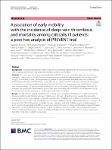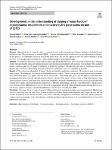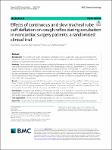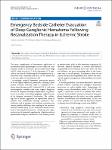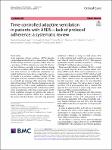Search
Author
- Daqing, Ma (3)
- Alexis, Ferré (2)
- Anna, Lybeck (2)
- Ashish K., Khanna (2)
- next >
Subject
- intensive care unit (8)
- acute respiratory dist... (5)
- chronic obstructive pu... (5)
- ICU (5)
- next >
Has File(s)
Search Results
There is inconclusive evidence regarding the effectiveness of extracorporeal cardiopulmonary resuscitation (ECPR) for out-of-hospital cardiac arrest (OHCA) patients. We aimed to evaluate the association between ECPR and neurologic recovery in OHCA patients using time-dependent propensity score matching analysis. |
Association of early mobility with the incidence of deep-vein thrombosis and mortality among critically ill patients: a post hoc analysis of PREVENT trial |
The Chain of Survival highlights the effectiveness of early recognition of cardiac arrest and call for help, early cardiopulmonary resuscitation and early defibrillation. Most patients, however, remain in cardiac arrest despite these interventions. Drug treatments, particularly the use of vasopressors, have been included in resuscitation algorithms since their inception. |
The pivotal ASPECT-NP trial showed ceftolozane/tazobactam was non-inferior to meropenem for the treatment of ventilated hospital-acquired/ventilator-associated bacterial pneumonia (vHABP/VABP). Here, we evaluated treatment outcomes by degree of respiratory or cardiovascular dysfunction. |
Impaired consciousness is common in intensive care unit (ICU) patients, and an individual’s degree of consciousness is crucial to determining their care and prognosis. However, there are no methods that continuously monitor consciousness and alert clinicians to changes. We investigated the use of physiological signals collected in the ICU to classify levels of consciousness in critically ill patients. |
Although the term “major fracture” is commonly used in the management of trauma patients, it is defined insufficiently to date. The polytrauma section of ESTES is trying to develop a more standardized use and a definition of the term. In this process, a standardized literature search was undertaken. We test the hypothesis that the understanding of “major fractures” has changed and is modified by a better understanding of patient physiology. |
Little data exist on the time spent by emergency department (ED) personnel providing intravenous (IV) fluid to ‘responsive’ versus ‘unresponsive’ patients. |
The incidence of cough reflex during extubation is 76%. Cough reflex causes severe hemodynamic fluctuations and airway complications. This prospective trial investigated the potential effects of tracheal tube cuff deflation on cough reflex during extubation. |
The main complication of intravenous application of recombinant tissue plasminogen activator (rtPA) in acute ischemic stroke is secondary intracerebral hemorrhage (sICH), which occurs in 1.7–8.8% of patients [1, 2], typically in the first 48 h following rtPA administration. It is associated with a mortality rate of up to 70%, mainly due to the mass effect of the hematoma [3]. |
Acute respiratory distress syndrome (ARDS) describes a polyetiological clinical picture characterized by diffuse alveolar damage and acute respiratory failure which has a prevalence of 10% in intensive care units [1]. One factor that influences mortality is the ventilatory strategy in invasively ventilated ARDS patients. Since the ARMA trial, there has been no multicenter randomized controlled trial that has been able to assign further mortality benefit to a particular ventilatory strategy [2]. The main goals of invasive ventilation strategies are to ensure an acceptable gas exchange while preventing ventilator-induced lung injury (VILI) therefore buying time for the lung to heal [3] |


